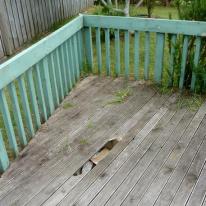Timber slat decks – split/damaged/rotten decking
Listed under: Exterior, timber and wood-based, timber, decks, durability, rot
Cause
The timber treatment was not adequate for the exposure
Repair
-
replace damaged or rotten decking. Options include:
-
H3.2 treated New Zealand-grown pine timber
-
New Zealand-grown macrocarpa timber
-
imported hardwood timbers such as kwila. Look for certification (from the Forest Stewardship Council or similar) that it is sustainably sourced
-
plastic/wood composite decking made from recycled HDPE plastic and rice husks, bamboo, and/or woodfibre, sawdust or woodwaste
-
seal timber ends immediately after cutting
-
follow the decking manufacturer and/or supplier’s recommendation for fixing. In some cases, especially with some hardwoods, this will be with stainless steel screws rather than nails and for composites, a concealed fixing system
-
follow the decking manufacturer and/or supplier’s recommendation for coating and maintenance.
Cause
The timber is at the end of its serviceable life
Repair
-
replace damaged or rotten decking. Options include:
-
H3.2 treated New Zealand-grown pine timber
-
New Zealand-grown macrocarpa timber
-
imported hardwood timbers such as kwila. Look for certification (from the Forest Stewardship Council or similar) that it is sustainably sourced
-
plastic/wood composite decking made from recycled HDPE plastic and rice husks, bamboo, and/or woodfibre, sawdust or woodwaste
-
seal timber ends immediately after cutting
-
follow the decking manufacturer and/or supplier’s recommendation for fixing. In some cases, especially with some hardwoods, this will be with stainless steel screws rather than nails and for composites, a concealed fixing system
-
follow the decking manufacturer and/or supplier’s recommendation for coating and maintenance.
Cause
Moisture remains trapped in the junctions of decking with framing
Repair
-
replace damaged or rotten decking. Options include:
-
H3.2 treated New Zealand-grown pine timber
-
New Zealand-grown macrocarpa timber
-
imported hardwood timbers such as kwila. Look for certification (from the Forest Stewardship Council or similar) that it is sustainably sourced
-
plastic/wood composite decking made from recycled HDPE plastic and rice husks, bamboo, and/or woodfibre, sawdust or woodwaste
-
seal timber ends immediately after cutting
-
follow the decking manufacturer and/or supplier’s recommendation for fixing. In some cases, especially with some hardwoods, this will be with stainless steel screws rather than nails and for composites, a concealed fixing system
-
follow the decking manufacturer and/or supplier’s recommendation for coating and maintenance.




